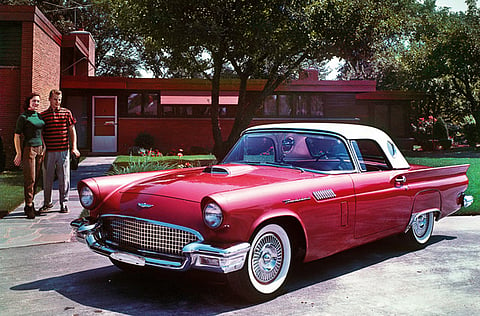Ford Thunderbird
The first generation of Ford’s iconic sportscar is one of the most desirable and accessible classic cars out there

If you look at the history of legendary sportscars, most of them are results of a group of engineers clandestinely working after-hours or a sudden brainwave of some maverick executive. The story of the Ford Thunderbird, inarguably one the most popular American cars ever, is not very different.
Legend has it that the seeds of the Thunderbird were sown in 1951 when Lewis Crusoe, division general manager, and George Walker, chief designer of Ford at the time, visited that year’s Paris motor show.
Hugely impressed by the gorgeous European sportscars on display, Crusoe apparently asked Walker, “Why don’t we have anything like that?” Work started as soon as they returned to Dearborn, and with General Motors bringing out the Corvette in 1953, the project got the official go-ahead from Henry Ford II.
In about a year, the Thunderbird was ready for display at the 1954 Detroit show. A lot of factors including a healthy economy and the car’s strikingly attractive styling worked in the Thunderbird’s favour. But the most important factor in its huge success was the failure of the first-generation Corvette with its shoddy fibreglass body and unimpressive six-cylinder engine.
It also helped that Ford promoted the Thunderbird as a personal luxury car, stressing more on the car’s creature comforts rather than its sportiness. And sure enough, comfort-loving Americans snapped up more than 16,000 Thunderbirds, while GM barely managed to sell 700 Corvettes.
Although the Thunderbird was a lot sleeker and better looking than other Fords of the time, many components and design characteristics were shared with these other models to keep cost in check.
The 2,591mm wheelbase chassis was a shortened version of an existing Ford platform, while the 193bhp 4.8-litre Y-block V8 was borrowed from Ford’s Mercury division.
Not wanting to upset the sales success, Ford didn’t bring about any change in 1956, except moving the spare tyre from the boot to the rear bumper and a porthole in the fibreglass roof to remedy a blind spot.
However, moving the spare tyre to the bumper proved a bad decision, as customers started complaining about heavy-tail-induced oversteer because of the added weight, forcing Ford to move it back to the boot in 1957.
That year also saw some styling and powertrain changes, with a larger grille and front bumper as well as larger canted fins in the rear making an appearance.
A 5.1-litre V8 putting out 215bhp when mated to either a three-speed manual, or 225bhp coupled with a two-speed auto became standard. There was also a high-performance version with a Paxton supercharger worth 300bhp.
A substantial redesign was commissioned in 1958, but many classic car lovers still swear by the first-generation Thunderbirds, which were produced between 1955 and 1957.
As with most classics, rust is an issue with the Thunderbird, but sourcing repair panels and other mechanical parts is easier than with many other cars. If maintained well, the Thunderbird could be your ultimate boulevard cruiser that’s also an elegant daily driver, provided the trip is not a long one.
And it won’t be out of your budget if you’re a first-time collector, as the price for a decent example can range anywhere between Dh100K and Dh300K.
What that gets you is one of the most iconic and most collectible of American classic cars.
Sign up for the Daily Briefing
Get the latest news and updates straight to your inbox

